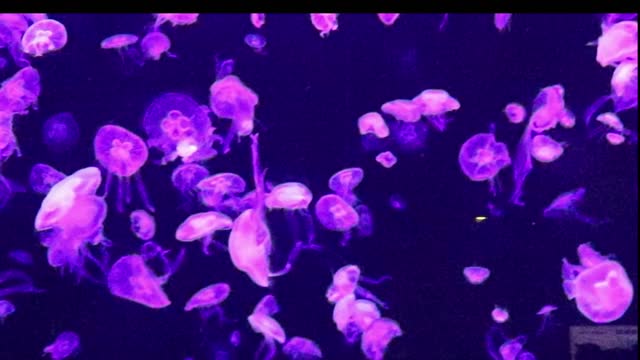Premium Only Content

Jelly fish overpowered by coloured lights!
1. Some jellyfish can glow in the dark
Many jellyfish have bioluminescent organs which emit blue or green light.
The light emission is typically activated by touch, which serves to startle predators. This light may also help jellyfish in a number of other ways, like attracting prey or warning other organisms that a particular area is occupied.
2. Jellyfish are the oldest multi-organ animal
Jellyfish have roamed the seas for at least 600 million years! Yes, before dinosaurs or bony fish, before creepy crawlies or trees, before flowers or ferns or fungi – there were jellyfish.
Jellyfish have survived five mass extinctions, including the Great Dying (or the Permian-Triassic extinction event) which wiped out up to 70% of life on Earth.
3. Jellyfish don’t have brains
Not only that, they also have no blood, no bones, and no heart. However, they do have an elementary nervous system with receptors that detect light, vibrations, and chemicals in the water. These abilities, along with the sense of gravity, allow jellyfish to orient and navigate in the water.
4. Jellyfish are found all over the world
Jellyfish are found in every ocean in every corner of the planet, from the coldest freezing waters of the Arctic oceans, to the warm, temperate waters of the tropical oceans.
They exist in different water conditions; at different depths from the ocean floor to the surface. They’re even found in some freshwater lakes and ponds!
5. Some jellyfish are immortal
Ever dreamed about being immortal? The good news is that you can be immortal. The bad news is that you have to become a floating blob of jelly to do so.
That’s right, there’s a death-defying species of jelly conveniently called the immortal jellyfish (or Turritopsis dohrnii) found in the Mediterranean Sea and in the waters of Japan that’s biologically immortal.
6. Not all jellyfish have tentacles
What are jellyfish known for? Some may say their trailing tentacles, but actually not all jellyfish species have tentacles. The Deepstaria, for example, is a genus of jellyfish known for their thin, sheet-like bodies and their lack of tentacles.
7. There’s a giant jellyfish called the hair jelly
The lion’s mane jellyfish (Cyanea capillata) – also known as the giant jellyfish or the hair jelly – is the largest known species of jellyfish.
The largest recorded specimen was found washed up on the shore of Massachusetts Bay in 1870. It had a bell with a diameter of 7 feet 6 inches and tentacles 121.4 feet long – longer than a blue whale and is considered one of the longest known animals in the world.
8. 150 million people are stung by jellyfish each year
That means that in the few minutes or so it’s taken you to read this far, more than 1,000 people have been stung by jellies.
9. Jellyfish stings can be deadly
The Australian box jellyfish (Chironex fleckeri) is considered the most venomous marine animal on earth. Its sting can cause paralysis, cardiac arrest, and death within a few minutes – barely enough time for a victim to swim to shore!
10. Jellyfish have many predators
Despite their venomous defenses, jellyfish are not without predators. Tunas, sharks, swordfish, sea turtles, and even some species salmon are jellyfish’s natural enemies that are known to prey upon jellies.
*All the information is obtained by open source, neither do I guarantee the authenticity nor do I claim ownership of the same
-
 LIVE
LIVE
Right Side Broadcasting Network
10 days agoLIVE REPLAY: President Donald J. Trump Keynotes TPUSA’s AmFest 2024 Conference - 12/22/24
2,474 watching -
 4:31
4:31
CoachTY
1 day ago $28.61 earnedCOINBASE AND DESCI !!!!
190K12 -
 10:02
10:02
MichaelBisping
1 day agoBISPING: "Was FURY ROBBED?!" | Oleksandr Usyk vs Tyson Fury 2 INSTANT REACTION
110K16 -
 8:08
8:08
Guns & Gadgets 2nd Amendment News
2 days ago16 States Join Forces To Sue Firearm Manufacturers Out of Business - 1st Target = GLOCK
130K93 -
 10:17
10:17
Dermatologist Dr. Dustin Portela
2 days ago $19.43 earnedOlay Cleansing Melts: Dermatologist's Honest Review
164K17 -
 1:02:20
1:02:20
Trumpet Daily
2 days ago $51.93 earnedObama’s Fake World Comes Crashing Down - Trumpet Daily | Dec. 20, 2024
119K85 -
 6:29
6:29
BIG NEM
1 day agoCultivating God Mode: Ancient Taoist NoFap Practices
86.2K22 -
 30:53
30:53
Uncommon Sense In Current Times
2 days ago $12.28 earned"Pardon or Peril? How Biden’s Clemency Actions Could Backfire"
95.3K10 -
 40:01
40:01
CarlCrusher
1 day agoSkinwalker Encounters in the Haunted Canyons of Magic Mesa - ep 4
86.3K10 -
 59:44
59:44
PMG
2 days ago $11.69 earned"BETRAYAL - Johnson's New Spending Bill EXPANDS COVID Plandemic Powers"
84.8K52